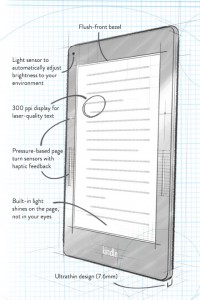
Amazon’s latest and greatist E-ink Kindle has sharper text, weighs less, and lights up better than the Paperwhite, but is it a must have upgrade?
The Voyage, Amazon’s latest addition to the Kindle line proves that they’re not abandoning e-ink in favor of their Fire LCD tablets, and that’s a good thing for the many readers who like their reading experience isolated from all the distractions the web is heir to, and who like the reduced eye-strain and wide range of lighting conditons that that e-ink can handle.
The Voyage has a host of features that Amazon touts as new or improved, but the most notable upgrad is the resolution. At 300 DPI it’s got 35% more pixels than the 221 Kindle Paperwhite, which will still be available, by the way. It’s also got “more contrast,” though as far as I could tell what that really means is that the backlight is brighter, maybe 20% or so. Comparing the Voyage and a Paperwhite side by side with the light turned off I’m unable to tell any difference in contrast, only the crispness granted by the higher resolution display. That crispness may actually be take down a miniscule amount by the specially etched glass on the Voyage, which provides effective anti-glare.
The light isn’t just brighter, it’s more even than on the Paperwhite, though it had never bothered me on the Paperwhite. The battery has a longer life, the screen is flush with its bezel, and it sports a 1 GHz 512 KB RAM processor, another slight improvement over the Paperwhite, which had 256 KB RAM. Not that I could tell any difference in speed of the two devices in casual inspection. The Voyage does seem to flip pages a bit faster than the Paperwhite, but as with most things on the device I wasn’t unhappy with the predecessor.
Now, it’s important to note that I’m comparing the Voyage to the second generation Paperwhite, release in September 2013. This device had some substantial upgrades in processor and memory over the original Paperwhite, most of which have been carried along to the new Kindle.
Besides the screen there are some significant design elements that set the Voyage apart from its predecessor. It’s slightly smaller and thinner, and about half an ounce lighter than the Paperwhite, thanks to a new magnesium body. That body has a more angular form factor than the rounded back of the Paperwhite, which Amazon no doubt thinks is a distinctive bit of design, but strikes me as less comfortable to hold than the Paperwhite, and the only area I give the device a serious downcheck.
Though the Voyage, like all Kindles now in production, has a touch screen, it’s been rezoned to better control, and the bezel sports actual pressure sensitive regions that provide page turning with haptic feedback, which you can dial up or down or turn off. I found myself accidentally skipping pages, or flipping in the wrong direction using the side switches and preffered just using the touch screen, but I’m confident that it’s just a matter of getting used to the interface.
Besides not being thrilled with the feel of the case, which is still not bad by any means, the only thing you can really ding the Voyage for is its price. Starting at $199 for the version that comes with ads when on the home screen when you’re not reading, you can crank the price all the way up to $269 if you want it with free 3G connectivity as well as WiFi. I settled for the middle of the road at $219 with just WiFi and no advertising. If you pick up the “Oragami” folding case, which is pretty clever, I’ll admit, and acts as a a useful stand for hands free reading at a desk or table, you’ll wind up shelling out another $44.99. The cover adheres magnetically, like an iPad’s. In fact it’s so clever-cool it’s hard to believe it didn’t come out of Apple’s design studio.
On average, the Voyage will set you back about $100 more than the Paperwhite, but is it worth it? It’s a tough call. If you don’t have a Kindle and are a heavy reader, which seems like an unlikely combination, then I’d say go for it. On the other hand, if you’ve got a 2nd generation Paperwhite and don’t suffer from gadget lust, you might consider staying with your device for another generation or two. E-ink has gotten better, thanks to increased resolution, but it’s still not paper-white, and 300 DPI is only half what most laser printers consider basic resolution.
Amazon is willing to tempt you with a generous 30-day trial period, but I think you’ll find it pretty hard to send the Voyage back. Speaking of sending them back, though you can’t sell your old Kindle on Amazon, you may be able to trade it in, if only for a few books worth of credit.
Links:
Amazon Voyage Homepage: http://www.amazon.com/dp/B00GDQDRPK